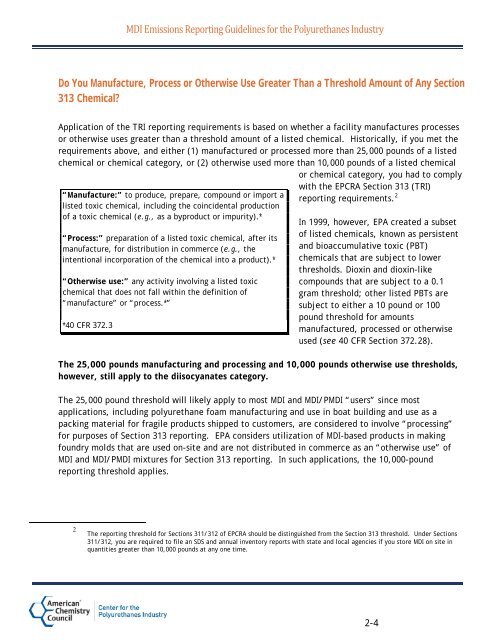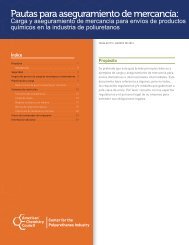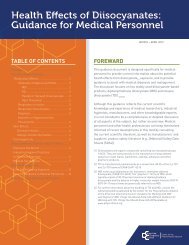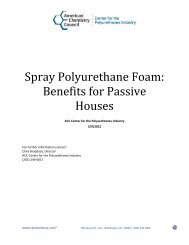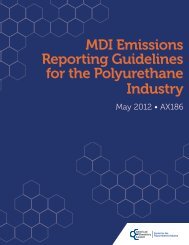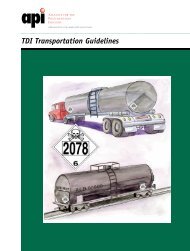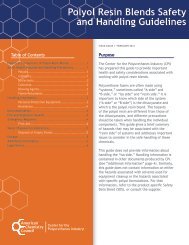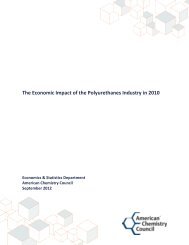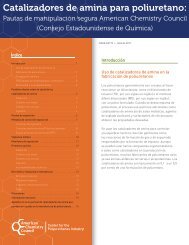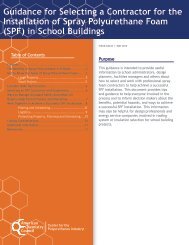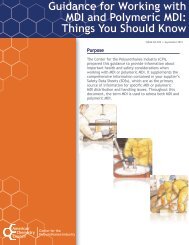MDI Emissions Reporting Guidelines for the ... - Polyurethanes
MDI Emissions Reporting Guidelines for the ... - Polyurethanes
MDI Emissions Reporting Guidelines for the ... - Polyurethanes
You also want an ePaper? Increase the reach of your titles
YUMPU automatically turns print PDFs into web optimized ePapers that Google loves.
<strong>MDI</strong> <strong>Emissions</strong> <strong>Reporting</strong> <strong>Guidelines</strong> <strong>for</strong> <strong>the</strong> <strong>Polyurethanes</strong> Industry<br />
Do You Manufacture, Process or O<strong>the</strong>rwise Use Greater Than a Threshold Amount of Any Section<br />
313 Chemical?<br />
Application of <strong>the</strong> TRI reporting requirements is based on whe<strong>the</strong>r a facility manufactures processes<br />
or o<strong>the</strong>rwise uses greater than a threshold amount of a listed chemical. Historically, if you met <strong>the</strong><br />
requirements above, and ei<strong>the</strong>r (1) manufactured or processed more than 25,000 pounds of a listed<br />
chemical or chemical category, or (2) o<strong>the</strong>rwise used more than 10,000 pounds of a listed chemical<br />
or chemical category, you had to comply<br />
“Manufacture:” to produce, prepare, compound or import a<br />
listed toxic chemical, including <strong>the</strong> coincidental production<br />
of a toxic chemical (e.g., as a byproduct or impurity).*<br />
“Process:” preparation of a listed toxic chemical, after its<br />
manufacture, <strong>for</strong> distribution in commerce (e.g., <strong>the</strong><br />
intentional incorporation of <strong>the</strong> chemical into a product).*<br />
“O<strong>the</strong>rwise use:” any activity involving a listed toxic<br />
chemical that does not fall within <strong>the</strong> definition of<br />
“manufacture” or “process.*”<br />
*40 CFR 372.3<br />
with <strong>the</strong> EPCRA Section 313 (TRI)<br />
reporting requirements. 2<br />
In 1999, however, EPA created a subset<br />
of listed chemicals, known as persistent<br />
and bioaccumulative toxic (PBT)<br />
chemicals that are subject to lower<br />
thresholds. Dioxin and dioxin-like<br />
compounds that are subject to a 0.1<br />
gram threshold; o<strong>the</strong>r listed PBTs are<br />
subject to ei<strong>the</strong>r a 10 pound or 100<br />
pound threshold <strong>for</strong> amounts<br />
manufactured, processed or o<strong>the</strong>rwise<br />
used (see 40 CFR Section 372.28).<br />
The 25,000 pounds manufacturing and processing and 10,000 pounds o<strong>the</strong>rwise use thresholds,<br />
however, still apply to <strong>the</strong> diisocyanates category.<br />
The 25,000 pound threshold will likely apply to most <strong>MDI</strong> and <strong>MDI</strong>/P<strong>MDI</strong> “users” since most<br />
applications, including polyurethane foam manufacturing and use in boat building and use as a<br />
packing material <strong>for</strong> fragile products shipped to customers, are considered to involve “processing”<br />
<strong>for</strong> purposes of Section 313 reporting. EPA considers utilization of <strong>MDI</strong>-based products in making<br />
foundry molds that are used on-site and are not distributed in commerce as an “o<strong>the</strong>rwise use” of<br />
<strong>MDI</strong> and <strong>MDI</strong>/P<strong>MDI</strong> mixtures <strong>for</strong> Section 313 reporting. In such applications, <strong>the</strong> 10,000-pound<br />
reporting threshold applies.<br />
2 The reporting threshold <strong>for</strong> Sections 311/312 of EPCRA should be distinguished from <strong>the</strong> Section 313 threshold. Under Sections<br />
311/312, you are required to file an SDS and annual inventory reports with state and local agencies if you store <strong>MDI</strong> on site in<br />
quantities greater than 10,000 pounds at any one time.<br />
2-4


